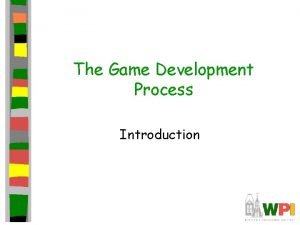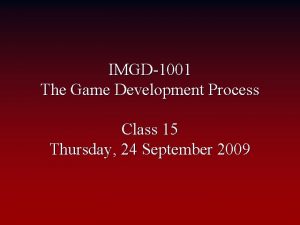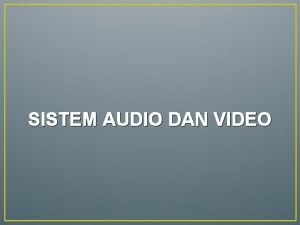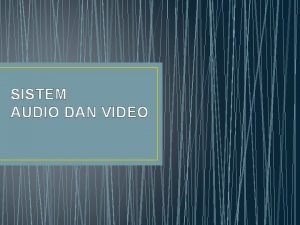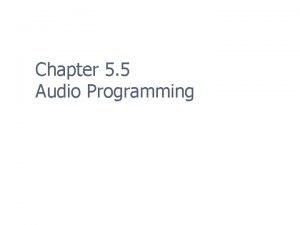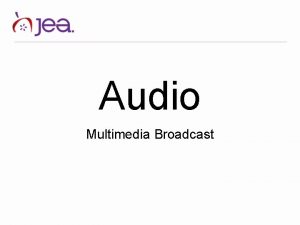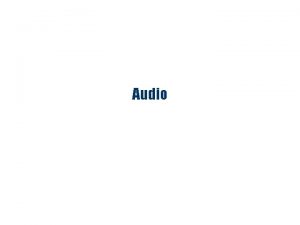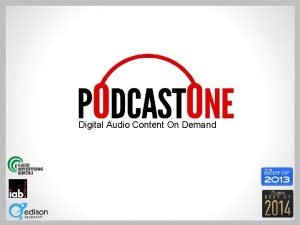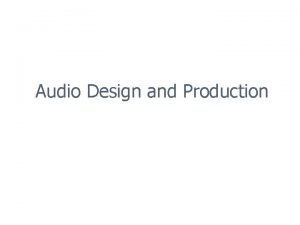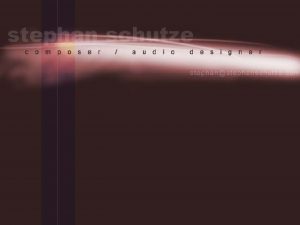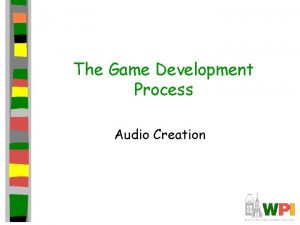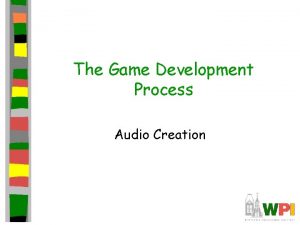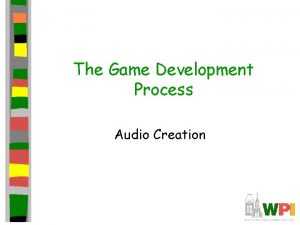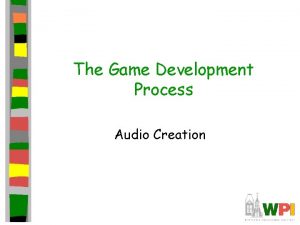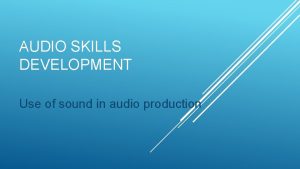IMGD1001 The Game Development Process Game Audio Content























- Slides: 23

IMGD-1001 The Game Development Process Game Audio (Content by professor Brian Moriarty)


Sound Audible vibration in an elastic medium (usually air)

Compression (positive pressure) Rarefaction (negative pressure)

Amount of pressure change = Amplitude Varies continuously over time

Rate of vibration/pressure change = Frequency Measured in cycles per second (Hertz or Hz)

Frequency range of human hearing: Approximately 20 to 20, 000 Hz

Analog recording and playback Transducers: Convert one type of energy to another All transducers introduce distortion

Digital audio n n n Experimental recordings: Late ‘ 60 s Jazz/classical: Early 70 s First symphonic recording: 1976 First major label recording: 1979 n Ry Cooder’s Bop Till You Drop Compact Disc n Jointly created by Sony/Phillips n Introduced October 1, 1982 n n Billy Joel’s 52 nd Street Biggest seller

Digital audio based on sampling Amplitude of signal is measured (and usually recorded) at precise time intervals, converted to stream of numbers



Digital recording and playback Extremely accurate, low noise and distortion Almost immeasurable wow or flutter Easily edited and manipulated Essentially perfect replication

Digital sampling (“digitizing”) n Sample rate Number of samples taken per second n Also measured in Hertz n n Sample resolution Range of numbers used to describe each sample n Measured in binary bits n 8 bits = 256 values (± 127) n 16 bits = 65, 536 values (± 32 K) n 24 bits = 16, 777, 216 values n

How often to sample? n Depends on desired frequency range Nyquist frequency = Sample rate required to fully express a signal n 2 X maximum required frequency n 2 X 20 k. Hz = 40 k. Hz minimum sample rate to represent full human range n

How much to sample? Depends on desired dynamic range n Dynamic range = Difference between softest and loudest sounds n Measured in decibels (d. B); 1 d. B = faintest perceptible sound n Real-world range: 10 -20 d. B (anechoic chamber) to 140 d. B (beside jet engine) n

Home audio formats n Compact Disc Sample rate: 44. 1 k. Hz n Sample resolution: 16 bits n Dynamic range: >90 d. B n Two channels for stereo n “CD quality” n n HD/Blu. Ray DVD Up to 8 channels 96 k. Hz 24 -bit audio n Dynamic range: >120 d. B n

“CD quality” data rate 44, 100 samples per second n 16 bits (2 bytes) per sample n 2 channels n 44, 100 x 2 = 176, 400 bytes/sec or 10. 584 MB per minute n Typical pop song 30 -40 MB if uncompressed n

Compressed digital audio n Lossless compression Preserves data perfectly n Compression ratio: 2: 1 typical n n Lossy compression Discards some data to increase compression ratio n The trick is: What to throw away? n

The game changer: MP 3 (1994) n Lossy compression algorithm based on auditory masking Loud low-frequency sounds can make softer high-frequency sounds inaudible n Perceptual coding: Throw away high frequencies that “can’t be heard anyway” n Compression ratio: 10: 1 or better n Pop song becomes a 3 MB file n

The MP 3 Phenomenon First Web appearance: Late ‘ 94 n Winamp, mp 3. com (Summer ’ 97) n First portable players (Spring ’ 98) n n n 32 MB Eiger MPMan F 10, Rio PMP 300 Napster (June ‘ 99)

Game audio: Early days Apple II and PC: Click the speaker n Atari, C 64, early consoles: FM synths n Macintosh (January 1984) n Ad. Lib PC sound card (1976) n Creative Labs Sound Blaster (1989) n n Ad. Lib with digital audio + game port

Game audio: Today n All game audio is digital n n Music, SFX, VO delivered prerendered Typical assets. wav (bigger, no decoding) n. mp 3 (small, decoded, may require license because of patent) n. ogg (small, decoded, no license) n. flac (smaller, decoded) n n Real-time mixing, effects,
 Real content and carrier content in esp
Real content and carrier content in esp Static content vs dynamic content
Static content vs dynamic content Game development process
Game development process Stages of game development
Stages of game development Simple game flowchart
Simple game flowchart Audio tour guide app development
Audio tour guide app development What is online platform for ict content development
What is online platform for ict content development Sitecore dam integration
Sitecore dam integration Qcto letter of intent
Qcto letter of intent Hát kết hợp bộ gõ cơ thể
Hát kết hợp bộ gõ cơ thể Frameset trong html5
Frameset trong html5 Bổ thể
Bổ thể Tỉ lệ cơ thể trẻ em
Tỉ lệ cơ thể trẻ em Gấu đi như thế nào
Gấu đi như thế nào Chụp tư thế worms-breton
Chụp tư thế worms-breton Alleluia hat len nguoi oi
Alleluia hat len nguoi oi Môn thể thao bắt đầu bằng từ đua
Môn thể thao bắt đầu bằng từ đua Thế nào là hệ số cao nhất
Thế nào là hệ số cao nhất Các châu lục và đại dương trên thế giới
Các châu lục và đại dương trên thế giới Công thức tiính động năng
Công thức tiính động năng Trời xanh đây là của chúng ta thể thơ
Trời xanh đây là của chúng ta thể thơ Mật thư anh em như thể tay chân
Mật thư anh em như thể tay chân 101012 bằng
101012 bằng Phản ứng thế ankan
Phản ứng thế ankan



